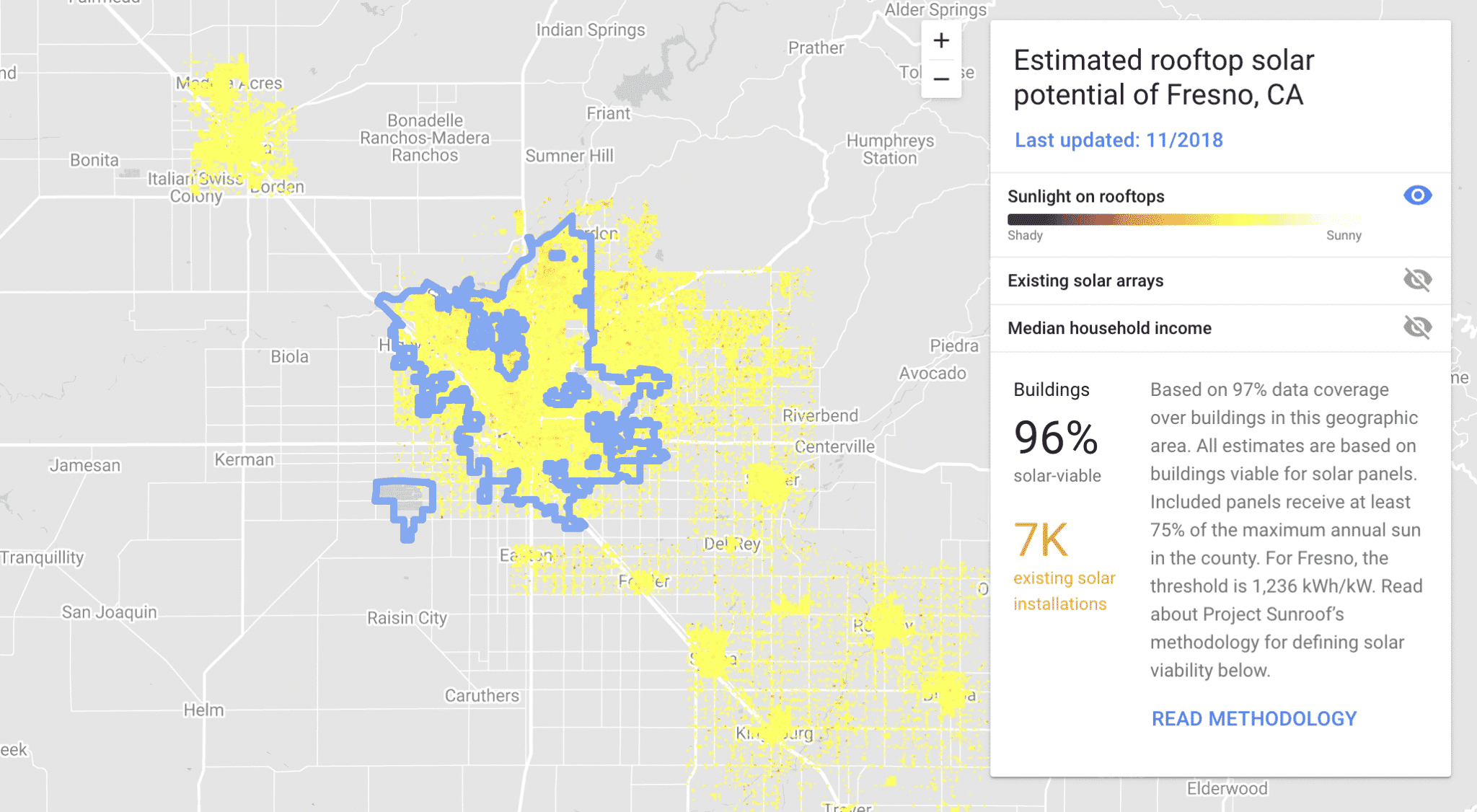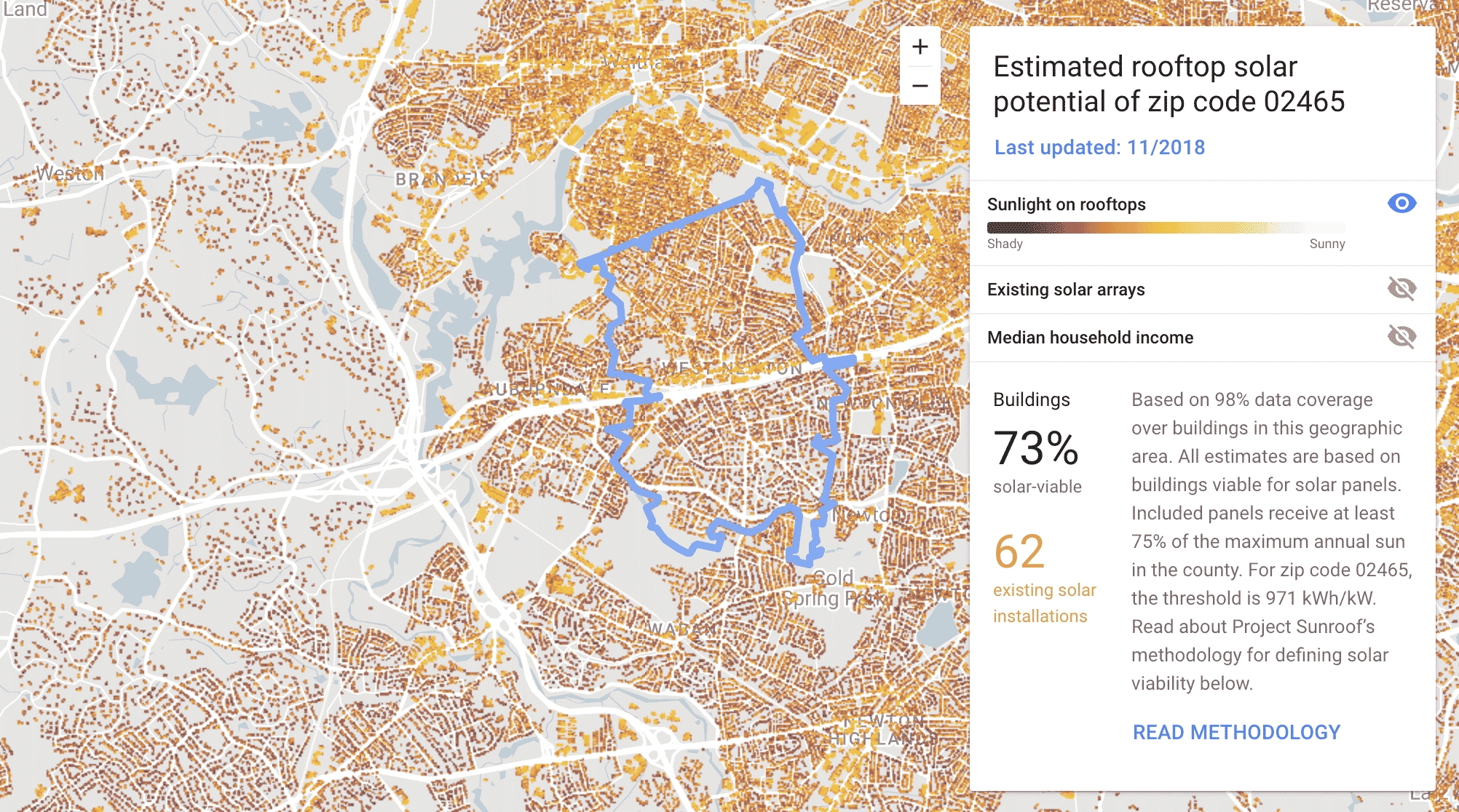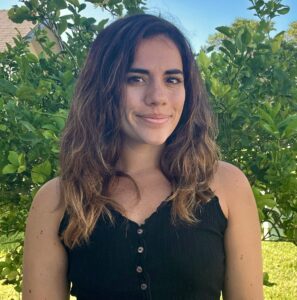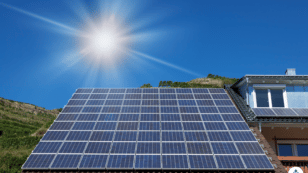

What is Google Project Sunroof and Is It Accurate? (2024 Guide)
Here are the key questions we’ll answer in this article:
- What is Google Project Sunroof?
- How Does Google Project Sunroof Work?
- Is Google Project Sunroof Accurate?
- Do We Recommend Using Google Project Sunroof?
Each product and or company featured here has been independently selected by the writer. You can learn more about our review methodology here. If you make a purchase using the links included, we may earn commission.
What Is Google Project Sunroof?
Google’s Project Sunroof is a free online tool that helps homeowners calculate solar energy potential based on their roof structure and local weather patterns. It was created in 2015 by a group of Google Engineers led by Carl Elkin.
Project Sunroof can calculate the sun’s path to give an accurate account of your solar situation. It then uses industry-standard models to tell you the cost-benefit analysis of going solar so you can decide if it’s worth it. In 2017, the tool added a feature that also shows you nearby homes that have installed solar energy systems.
Currently, the Google Project Sunroof data explorer is only available in the U.S. and Germanyhow

SunPower
Pros
- Most efficient panels on the market
- National coverage
- Cradle to Cradle sustainability certification
- Great warranty coverage
Cons
- Expensive
- Customer service varies by local dealer
SunPower designs and installs industry-leading residential solar and storage solutions across all 50 states. With a storied history of innovation dating back to 1985, no other company on this list can match SunPower’s experience and expertise.
SunPower earns its position as the top national installer on our list for a handful of reasons: It installs the most efficient solar technology on the residential market, offers the most expansive service area and backs its installations with a warranty well above the industry standard. All the while, SunPower pioneers sustainability efforts within the industry.
If that weren’t enough, SunPower systems come packaged with products all manufactured in-house by its sister company, Maxeon. This means that your panels, solar cells, inverters, battery and EV chargers are designed to work together and are all covered under the same warranty.
SunPower’s biggest downside? Its high-efficiency panels are considerably more expensive than most of its competitors’ products. However, its powerful panels are workhorses that make up for the initial cost with more backend production (think about this like spending more money for a car that gets more miles per gallon).
Facts and Figures: SunPower
| EcoWatch Rating |
|---|
| Better Business Bureau (BBB) Rating |
| Year Founded |
| Average Cost ($-$$$$$) |
| Solar Services |
| Brands of Solar Equipment Offered |
| Warranty Coverage |
| 5 |
| A+ |
| 1985 |
| $$$$ |
| Solar Panels, Solar Batteries, EV Chargers, System Monitoring |
| SunPower Panels |
| 25-year all-inclusive warranty |

Blue Raven Solar
Pros
- Industry-leading in-house financing
- Competitive pricing
- Excellent reputation
Cons
- Doesn't offer solar batteries (coming 2022)
We like Blue Raven Solar because it understands that, for most homeowners, the cost of solar presents the biggest barrier to entry.
For that reason, Blue Raven Solar developed an innovative solar financing plan that offers in-house, flexible, zero-money-down options. The results speak for themselves, as Blue Raven Solar is now one of the fastest-growing solar companies in the nation and was recently acquired by SunPower. Its BluePower Plus+ plan (exclusive to Blue Raven) mimics the flexible structure of a lease while still providing the greatest benefits of owning your system.
Eligible homeowners enjoy 18 months of solar power before having to pay their first bill. When coupled with the federal solar investment tax credit (ITC), the initial energy savings can offset more than a third of the overall cost of a system before requiring a dollar down.
In contrast, other installers can only offer similar financing through solar leases, PPAs or third-party providers (such as Mosaic or Sunlight). Third-party loan providers can complicate the process, while opting for a loan or PPA will disqualify you from some of solar’s biggest benefits (additional property value, federal solar tax credit and local solar incentives).
Facts and Figures: Blue Raven Solar
| EcoWatch Rating |
|---|
| Better Business Bureau (BBB) Rating |
| Year Founded |
| Average Cost ($-$$$$$) |
| Solar Services |
| Brands of Solar Equipment Offered |
| Warranty Coverage |
| 4.5 |
| A+ |
| 2014 |
| $$ |
| Solar Panels, System Monitoring |
| Trina Solar, Canadian Solar, SolarEdge, Silfab, SunPower |
| 25-year manufacturer warranty; 10-year workmanship warranty, 2-year production guarantee |
 How Does Google Project Sunroof Work?
How Does Google Project Sunroof Work?
Project Sunroof is a smart tool using satellite imagery, 3D modeling and shade calculations from a combination of Google Maps, Google Earth and machine learning technology. However, Google doesn’t work alone in this.
According to its website, Project Sunroof also uses weather and solar savings data from the National Renewable Energy Laboratory (NREL), as well as utility electricity rates, solar costs and tax credit data from other third-party sources.1
Additionally, a machine learning algorithm is trained to recognize solar panels from satellite images and obtain information about which buildings are already using solar panels.
How to Use Google Project Sunroof For Your Home
Google Project Sunroof is pretty user-friendly. You can get a quick, personalized solar analysis for your home with just three simple steps:
- Search for your home
- Add your electric bill information to get a more accurate solar savings estimate
- Compare solar financing options
How to Use Google Project Sunroof For Your City
Another function Google’s Project Sunroof offers is the ability to see solar data for an entire city. For example, in Fresno, California, 96% of rooftops are viable for solar. If all were to reach solar capacity, the carbon offset would be equivalent to taking 278,000 cars off the road each year or planting 21.3 million trees.
How Accurate is Google Project Sunroof?

Just in the past year alone, California rolled out net metering 3.0, which had an enormous impact on how viable solar is in the area, and it likely cut potential savings by between 25% and 50% for many customers.
For example, Google estimates that a solar system in Houston, Texas, would be about $26,000 after applying the federal solar tax credit.3 Using internal solar data from 2024, EcoWatch found the average cost of a solar system in Houston to be about $36,570. As you can see, the figure from Project Sunroof is more than $10,000—almost 50%—off, based on our data.
It also overestimates the solar panel payback period, in our opinion. For that same Houston property, it estimates 16 years, while our internal data suggests it would only take 12 years. However, the long-term benefits do seem to be accurate in this case—$30,000 in net savings as opposed to our internal data, which suggest $32,651.
While solar calculators like this are helpful, the only way to get an accurate solar estimate for your home is to get a quote from a certified solar provider.

Do We Recommend Using Google Project Sunroof?
Here’s the thing: Google Project Sunroof is a great tool, but if you’re looking to install rooftop solar panels, we recommend using other resources along with Project Sunroof.
It can provide some general feedback on whether or not your home is a decent fit for solar, but for specific cost and savings information, you really need more than Project Sunroof alone.
What We Like About Google Project Sunroof
Google Project Sunroof provides helpful information to prospective homeowners about solar potential and the feasibility of adding a solar system. Project Sunroof is a completely free resource, and Google claims it doesn’t make any money off of the tool, which means its sole purpose is to accelerate the growth of solar power to help mitigate carbon emissions. That’s something we can get behind.
Just to give an example of the impact this tool has had, one of the largest rooftop solar installations in Houston was prompted by Project Sunroof naming Houston the “most promising city in the U.S. for solar potential.”4 This, undoubtedly, has helped Texas reach the number two spot in the country for solar installations, according to the Solar Energy Industries Association (SEIA).
What We Don’t Like About Google Project Sunroof
While Google Project Sunroof has great intentions and features, it’s not without its flaws. For one, Project Sunroof is also only helpful for those looking for rooftop solar panels and doesn’t provide any data for ground-mounted solar systems.
In our opinion, the biggest flaw of Project Sunroof is that a lot of its information can be outdated in some areas. As we mentioned earlier, much of the app has not been updated since 2018, but solar energy has become more accessible and affordable since then, and incentives change all the time that affect the viability and affordability of solar. As such, Google’s quotes can sometimes be higher than that of a solar installation company near you, and they can also go the other way and be much lower than reality.
Lastly, Google Project Sunroof cannot connect you to a local solar provider. If you’re interested in getting a free quote for your home solar project, click below.
The cost information presented in this article is derived from a comprehensive analysis, incorporating data from multiple industry sources. The average cost per watt per state was calculated based on figures from Consumer Affairs, Energy Sage, and Berkeley Lab’s Electricity Markets & Policy Department. Additionally, monthly energy consumption and the average monthly cost of electricity were sourced from the U.S. Energy Information Administration, ensuring a well-rounded and accurate representation of the information presented.
Comparing authorized solar partners
-
- Most efficient panels on the market
- National coverage
- Cradle to Cradle sustainability certification
- Great warranty coverage
- Expensive
- Customer service varies by local dealer
A+Best National Provider1985SunPower Panels25-year all-inclusive warranty
Having trouble deciding? Click below and use our process to receive multiple quotes instead:

 233k
233k  41k
41k  Subscribe
Subscribe 


 How Does Google Project Sunroof Work?
How Does Google Project Sunroof Work?





